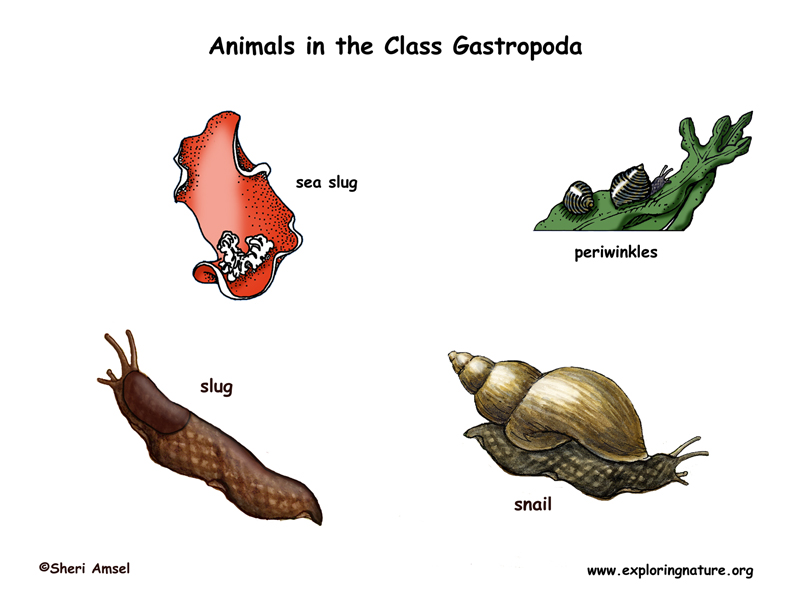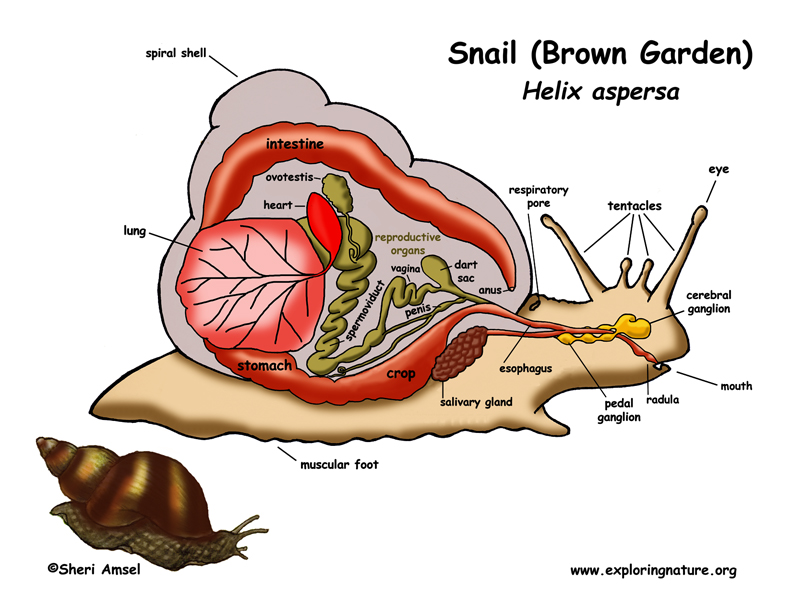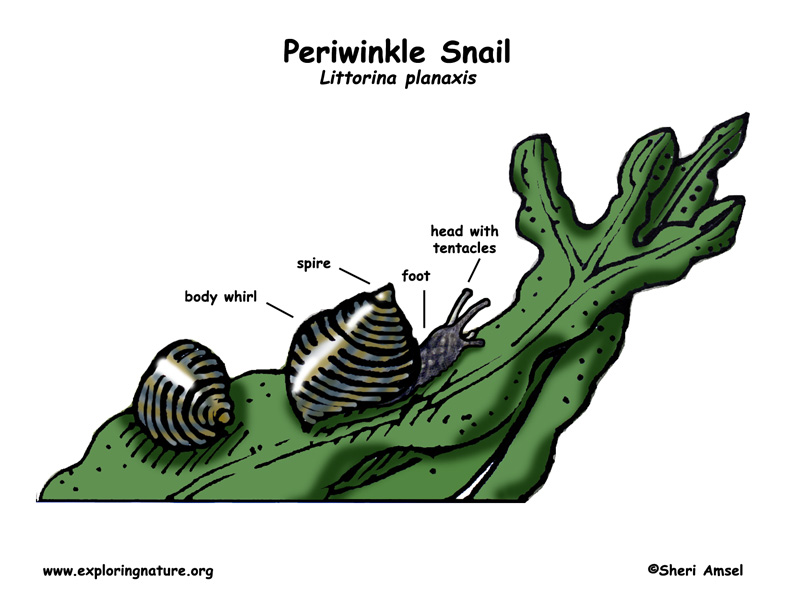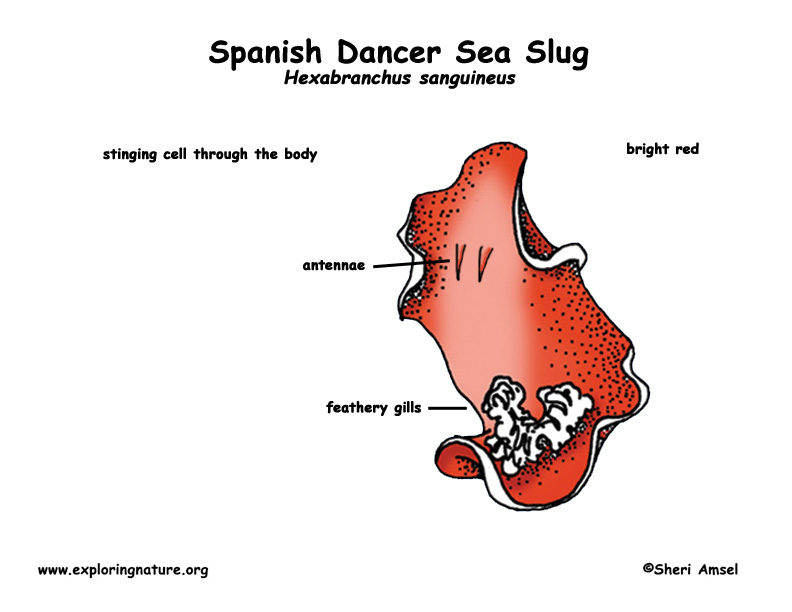

The Gastropods
The gastropods include snails, slugs, conchs, periwinkles and sea slugs.
Habitat: They are found in both salt (marine) and freshwater habitats and on land.
Diet: Some gastropods are herbivores using the radula to scrape off food particles. Others are carnivores and use the radula to penetrate the shells of their prey.
Physical Traits:
They have a large, muscular foot on which they move slowly along any surface and the visceral mass sits atop the foot. Many gastropods have shells, though not all. Both the slug and the sea slug (nudibranch) lack a shell. Snails and slugs breathe through respiratory pores, the oxygen being absorbed directly into the abundant tiny blood vessels of the mantle. In the more aquatic gastropods, there are gills instead. Snails have an odd development, the young going through a torsion that results in the anus emptying waste out at the back of the head. They have a spiral shell and a tough plate, called an operculum, that can seal them inside in case of danger. They have a rough, tongue-like structure, called a radula, with which they scrape away at food. They also have two pairs of tentacles, only one bearing eyes at the end.
Found throughout the world in temperate climates, they live in the moist vegetation of gardens, woods and yards.
The have a muscular foot with which they move. They secrete a thick mucus that helps them move over surfaces and leaves a trail. They have a spiral shell inside and around which their body wraps. The shell has ringed markings and is yellowish-brown. The shell reaches about 1.5 inches wide (4 cm) and has a tough plate, called an operculum, that can seal the snail inside in case of danger. They have a rough, tongue-like structure, called a radula, with which they scrape away at food. They have two pairs of tentacles, only one bearing eyes at the end. They breathe through respiratory pores, the oxygen being absorbed directly into the abundant tiny blood vessels of the mantle.
They are active at night (nocturnal). They will emerge during day after a rainfall. They survive the winter by hibernating.
They eat plants (herbivores).
Each snail contains both male and female reproductive parts. This makes them "hermaphrodites." They still choose to mate with other snails, though they can fertilize themselves. After mating, the snails dig a pit in the ground and lay their eggs.
They are found on the coast from Alaska to Baja California attached to docks, wooden pilings and rocky areas in bays and on shorelines.
They have a sharp structure in their mouth called a radula. It is rows of sharp, hooked teeth for scraping algal food off rocks. They can replace up to 7 rows of teeth in one day. They can close themselves into their shells using their tail to keep from drying out or protect themselves from predators. Their doorway out of their shell is called the operculum.
They travel up and down the rocks with the tide, crawling out of the tide pool at night and back in during the day. They hide at low tide in groups in cracks or crevices. They secrete a special mucus around the opening to their shell. This hardens, cementing them to the rocks. When they are hungry they eat away the hardened mucus and crawl around.
They scrape plant scum off the rocky surfaces with a special structure in their mouth called a radula.
Once a year, males find a female for mating. Females lay their eggs in a mucus bundle in tide pools. The larvae hatch and are washed out to sea to grow.
Sea slugs are found throughout the world's oceans. There many species of sea slug. The Spanish Dancer is found in the tropical Indo-Pacific Ocean and the Red Sea.
Sea slugs live mostly in warm, tropical waters on the ocean floor. They are rarely found in cooler waters and are rarely swimming in open water.
There are many different kinds of sea slugs, all with different bright colors and patterns. Though they are in the same family as snails, they have little or no shell. They are poisonous and very few animals will eat them. The Spanish Dancer is one of the largest sea slugs reaching 15 inches long (40 cm). They are bight red and their swimming motion looks like the waving skirts of a Spanish Dancer.
When threatened by predators, they shoot out an inky, acid spray to scare them off. Only crabs and lobsters can eat them.
They eat animals (carnivores) like sponges, anemones, corals, and barnacles.
They have both male and female organs so can mate with any sea slug of their species that they meet. They lay their eggs in masses on or near an animal they eat for hatching young to have a first meal.
When you research information you must cite the reference. Citing for websites is different from citing from books, magazines and periodicals. The style of citing shown here is from the MLA Style Citations (Modern Language Association).
When citing a WEBSITE the general format is as follows.
Author Last Name, First Name(s). "Title: Subtitle of Part of Web Page, if appropriate." Title: Subtitle: Section of Page if appropriate. Sponsoring/Publishing Agency, If Given. Additional significant descriptive information. Date of Electronic Publication or other Date, such as Last Updated. Day Month Year of access < URL >.
Amsel, Sheri. "Class - Gastropoda (Snails, Slugs, Conchs, Periwinkles and Sea Slugs)" Exploring Nature Educational Resource ©2005-2025. January 13, 2025
< http://www.exploringnature.org/db/view/Class-Gastropoda-Snails-Slugs-Conchs-Periwinkles-and-Sea-Slugs >




